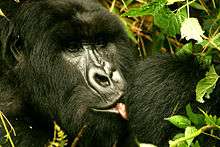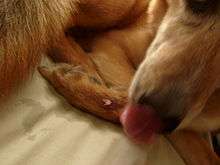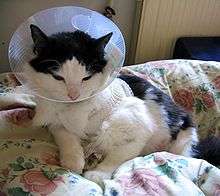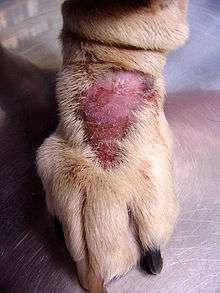Wound licking
Wound licking is an instinctive response in humans and many other animals to lick an injury. Dogs, cats, small rodents, horses, and primates all lick wounds.[1] Saliva contains tissue factor which promotes the blood clotting mechanism. The enzyme lysozyme is found in many tissues and is known to attack the cell walls of many gram-positive bacteria, aiding in defense against infection. Tears are also beneficial to wounds due to the lysozyme enzyme. However, there are also infection risks due to bacteria in the human mouth.

Mechanism

Oral mucosa heals faster than skin,[2] suggesting that saliva may have properties that aid wound healing. Saliva contains cell-derived tissue factor, and many compounds that are antibacterial or promote healing. Salivary tissue factor, associated with microvesicles shed from cells in the mouth, promotes wound healing through the extrinsic blood coagulation cascade.[3][4][5] The enzymes lysozyme and peroxidase,[6] defensins,[7] cystatins and an antibody, IgA,[8] are all antibacterial. Thrombospondin and some other components are antiviral.[9][10] A protease inhibitor, secretory leukocyte protease inhibitor, is present in saliva and is both antibacterial and antiviral, and a promoter of wound healing.[11][12] Nitrates that are naturally found in saliva break down into nitric oxide on contact with skin, which will inhibit bacterial growth.[13] Saliva contains growth factors[14] such as epidermal growth factor,[15] VEGF,[16] TGF-β1,[17] leptin,[18][19] IGF-I,[20][21] lysophosphatidic acid,[22][23] hyaluronan[24] and NGF,[25][26][27] which all promote healing, although levels of EGF and NGF in humans are much lower than those in rats. In humans, histatins may play a larger role.[28][29] As well as being growth factors, IGF-I and TGF-α induce antimicrobial peptides.[30] Saliva also contains an analgesic, opiorphin.[31] Licking will also tend to debride the wound and remove gross contamination from the affected area. In a recent study, scientists have confirmed through several experiments that the protein responsible for healing properties in human saliva is, in fact, histatin. Scientists are now looking for ways to make use of this information in ways that can lead to chronic wounds, burns, and injuries being healed by saliva, making this type of treatment as common as antibiotic creams and rubbing alcohol.[32]
In animals


It has been long observed that the licking of their wounds by dogs might be beneficial. Indeed, a dog's saliva is bactericidal against the bacteria Escherichia coli and Streptococcus canis, although not against coagulase positive Staphylococcus or Pseudomonas aeruginosa.[33] Wound licking is also important in other animals. Removal of the salivary glands of mice[34] and rats slows wound healing, and communal licking of wounds among rodents accelerates wound healing.[35][36] Communal licking is common in several primate species. In macaques, hair surrounding a wound and any dirt is removed, and the wound is licked, healing without infection.[37]
Risks
Wound licking is beneficial but too much licking can be harmful. An Elizabethan collar may be used on pet animals to prevent them from biting an injury or excessively licking it, which can cause a lick granuloma. These lesions are often infected by pathogenic bacteria such as Staphylococcus intermedius.[38] Horses that lick wounds may become infected by a stomach parasite, Habronema, a type of nematode worm. The rabies virus may be transmitted between animals, such as the kudu antelopes by wound licking of wounds with residual infectious saliva.[39]
In humans
Legend
There are many legends involving healing wounds by licking them or applying saliva. Saint Magdalena de Pazzi is said to have cured a nun of sores and scabs in 1589 by licking her limbs.[40] The Roman Emperor Vespasian is said to have performed a healing of a blind man using his saliva.[41] Pliny the Elder in his Natural History reported that a fasting woman's saliva is an effective cure for bloodshot eyes.
Risks
There are potential health hazards in wound licking due to infection risk, especially in immunocompromised patients. Human saliva contains a wide variety of bacteria that are harmless in the mouth, but that may cause significant infection if introduced into a wound. A notable case was a diabetic man who licked his bleeding thumb following a minor bicycle accident, and subsequently had to have the thumb amputated after it became infected with Eikenella corrodens from his saliva.[42]
Licking of people's wounds by animals
History and legend
Dog saliva has been said by many cultures to have curative powers in people.[43][44] "Langue de chien, langue de médecin" is a French saying meaning "A dog's tongue is a doctor's tongue", and a Latin quote that "Lingua canis dum lingit vulnus curat" or "A dog's saliva can heal your wound" appears in a thirteenth-century manuscript.[45] In Ancient Greece, dogs at the shrine of Aesculapius were trained to lick patients, and snake saliva was also applied to wounds.[46] Saint Roch in the Middle Ages was said to have been cured of a plague of sores by licking from his dog.[47] The Assyrian Queen Semiramis is supposed to have attempted to resurrect the slain Armenian king Ara the Beautiful by having the dog god Aralez lick his wounds.[48] In the Scottish Highlands in the nineteenth century, dog lick was believed to be effective for treating wounds and sores.[49] In the Gospel of Luke (16:19-31), Lazarus the Beggar's sores are licked by dogs, although no curative effects are reported by the Evangelist.
Modern cases
There are contemporary reports of the healing properties of dog saliva. Fijian fishermen are reported to allow dogs to lick their wounds to promote healing,[13] and a case of dog saliva promoting wound healing was reported in the Lancet medical journal.[50]
Risks
As with the licking of wounds by people, wound licking by animals carries a risk of infection. Allowing pet cats to lick open wounds can cause cellulitis[51][52] and sepsis[53][54] due to bacterial infections. Licking of open wounds by dogs could transmit rabies if the dog is infected with rabies,[55] although this is said by the CDC to be rare.[56] Dog saliva has been reported to complicate the healing of ulcers.[57] Another issue is the possibility of an allergy to proteins in the saliva of pets, such as Fel d 1 in cat allergy and Can f 1 in dog allergy.[58] Cases of serious infection following the licking of wounds by pets include:
- Dog
- A diabetic man who was infected by Pasteurella dagmatis due to the licking of his injured toe by his dog, causing a spinal infection.[59]
- A woman recovering from knee surgery suffered a persistent infection of the knee with Pasteurella after her dog licked a small wound on her toe.[60]
- A dog lick to an Australian woman's minor burn caused sepsis and necrosis due to Capnocytophaga canimorsus infection, resulting in the loss of all her toes, fingers and a leg.[61][62]
- C. canimorsus caused acute kidney failure due to sepsis in a man whose open hand wound was licked by his dog.[63]
- A 68-year-old man died from sepsis and necrotizing fasciitis after a wound was licked by his dog.[64]
- A patient with a perforated eardrum developed meningitis after his dog passed on a Pasteurella multocida infection by licking his ear.[65]
- Cat
- A woman recovering from surgery for endometrial cancer suffered from Pasteurella multocida infection causing an abscess after her cat licked the incision.[66]
- A blood donor whose cat licked her chapped fingers passed on Pasteurella infection to a 74-year-old transfusion recipient.[67]
- A seven-week-old boy contracted meningitis due to Pasteurella from contact with pet saliva.[68]
Idiomatic use
| Look up lick one's wounds in Wiktionary, the free dictionary. |
To "lick your wounds" means to "withdraw temporarily while recovering from a defeat"[69]
The phrase was spoken by Antony in John Dryden's seventeenth century play All for Love:[70]
They look on us at distance, and, like curs
Scaped from the lion's paws, they bay far off
And lick their wounds, and faintly threaten war.
See also
- Cat scratch fever
- Folklore
- Maggot therapy
- Personal grooming
- Skin repair
- Vampire bat feeding
- Zoonosis
References
- Engel, Cindy (2003). Wild Health: Lessons in Natural Wellness from the Animal Kingdom. Houghton Mifflin Harcourt. ISBN 9780618340682.
- Szpaderska AM, Zuckerman JD, DiPietro LA (August 2003). "Differential Injury Responses in Oral Mucosal and Cutaneous Wounds". J. Dent. Res. 82 (8): 621–6. doi:10.1177/154405910308200810. PMID 12885847.
- Glazko AJ, Greenberg DM (1938). "The mechanism of the action of saliva in blood coagulation". Am J Physiol. 125: 108–12. doi:10.1152/ajplegacy.1938.125.1.108.
- Berckmans RJ, Sturk A, van Tienen LM, Schaap MC, Nieuwland R (2011). "Cell-derived vesicles exposing coagulant tissue factor in saliva". Blood. 117 (11): 3172–80. doi:10.1182/blood-2010-06-290460. PMID 21248061.
- Gross PL (2011). "Salivary microvesicles clot blood". Blood. 117 (11): 2989. doi:10.1182/blood-2011-02-332759. PMID 21415275.
- Ihalin R, Loimaranta V, Tenovuo J (January 2006). "Origin, structure, and biological activities of peroxidases in human saliva". Arch Biochem Biophys. 445 (2): 261–8. doi:10.1016/j.abb.2005.07.004. PMID 16111647.
- Abiko Y, Nishimura M, Kaku T (2003). "Defensins in saliva and the salivary glands". Med Electron Microsc. 36 (4): 247–52. doi:10.1007/s00795-003-0225-0. PMID 16228657.
- Schenkels LC, Veerman EC, Nieuw Amerongen AV (1995). "Biochemical composition of human saliva in relation to other mucosal fluids". Crit. Rev. Oral Biol. Med. 6 (2): 161–75. CiteSeerX 10.1.1.494.57. doi:10.1177/10454411950060020501. PMID 7548622.
- Campo J, Perea MA, del Romero J, Cano J, Hernando V, Bascones A (May 2006). "Oral transmission of HIV, reality or fiction? An update". Oral Dis. 12 (3): 219–28. doi:10.1111/j.1601-0825.2005.01187.x. PMID 16700731. Archived from the original on 8 January 2012.
- Baron S, Singh I, Chopra A, Coppenhaver D, Pan J (November 2000). "Innate antiviral defenses in body fluids and tissues". Antiviral Res. 48 (2): 71–89. doi:10.1016/S0166-3542(00)00126-1. PMID 11114410.
- Ashcroft GS, Lei K, Jin W, et al. (October 2000). "Secretory leukocyte protease inhibitor mediates non-redundant functions necessary for normal wound healing". Nat. Med. 6 (10): 1147–53. doi:10.1038/80489. PMID 11017147.
- Kate Wong: A Protein's Healing Powers. Scientific American 2 October 2000
- Benjamin N, Pattullo S, Weller R, Smith L, Ormerod A (June 1997). "Wound licking and nitric oxide". Lancet. 349 (9067): 1776. doi:10.1016/S0140-6736(05)63002-4. PMID 9193412.
- Zelles T, Purushotham KR, Macauley SP, Oxford GE, Humphreys-Beher MG (December 1995). "Saliva and growth factors: the fountain of youth resides in us all". J. Dent. Res. 74 (12): 1826–32. doi:10.1177/00220345950740120301. PMID 8600176.
- Jahovic N, Güzel E, Arbak S, Yeğen BC (September 2004). "The healing-promoting effect of saliva on skin burn is mediated by epidermal growth factor (EGF): role of the neutrophils". Burns. 30 (6): 531–8. doi:10.1016/j.burns.2004.02.007. PMID 15302417.CS1 maint: multiple names: authors list (link)
- Pammer J, Weninger W, Mildner M, Burian M, Wojta J, Tschachler E (October 1998). "Vascular endothelial growth factor is constitutively expressed in normal human salivary glands and is secreted in the saliva of healthy individuals". J. Pathol. 186 (2): 186–91. doi:10.1002/(SICI)1096-9896(1998100)186:2<186::AID-PATH148>3.0.CO;2-J. PMID 9924435. Archived from the original on 5 January 2013.
- Schrementi ME, Ferreira AM, Zender C, DiPietro LA (2008). "Site-specific production of TGF-beta in oral mucosal and cutaneous wounds". Wound Repair Regen. 16 (1): 80–6. doi:10.1111/j.1524-475X.2007.00320.x. PMID 18086295. Archived from the original on 5 January 2013.
- Frank S, Stallmeyer B, Kämpfer H, Kolb N, Pfeilschifter J (August 2000). "Leptin enhances wound re-epithelialization and constitutes a direct function of leptin in skin repair". J. Clin. Invest. 106 (4): 501–9. doi:10.1172/JCI9148. PMC 380250. PMID 10953025.
- Gröschl M, Topf HG, Kratzsch J, Dötsch J, Rascher W, Rauh M (April 2005). "Salivary leptin induces increased expression of growth factors in oral keratinocytes". J. Mol. Endocrinol. 34 (2): 353–66. doi:10.1677/jme.1.01658. PMID 15821102.
- Costigan DC, Guyda HJ, Posner BI (May 1988). "Free insulin-like growth factor I (IGF-I) and IGF-II in human saliva". J. Clin. Endocrinol. Metab. 66 (5): 1014–8. doi:10.1210/jcem-66-5-1014. PMID 3360895.
- Todorović V, Pesko P, Micev M, et al. (October 2008). "Insulin-like growth factor-I in wound healing of rat skin". Regul. Pept. 150 (1–3): 7–13. doi:10.1016/j.regpep.2008.05.006. PMID 18597865.
- Sugiura T, Nakane S, Kishimoto S, Waku K, Yoshioka Y, Tokumura A (December 2002). "Lysophosphatidic acid, a growth factor-like lipid, in the saliva". J. Lipid Res. 43 (12): 2049–55. doi:10.1194/jlr.M200242-JLR200. PMID 12454265.
- Balazs L, Okolicany J, Ferrebee M, Tolley B, Tigyi G (1 February 2001). "Topical application of the phospholipid growth factor lysophosphatidic acid promotes wound healing in vivo". Am. J. Physiol. Regul. Integr. Comp. Physiol. 280 (2): R466–72. doi:10.1152/ajpregu.2001.280.2.R466. PMID 11208576.
- Pogrel MA, Low MA, Stern R (June 2003). "Hyaluronan (hyaluronic acid) and its regulation in human saliva by hyaluronidase and its inhibitors" (PDF). J Oral Sci. 45 (2): 85–91. doi:10.2334/josnusd.45.85. PMID 12930131.
- Li AK, Koroly MJ, Schattenkerk ME, Malt RA, Young M (July 1980). "Nerve growth factor: acceleration of the rate of wound healing in mice". Proc. Natl. Acad. Sci. U.S.A. 77 (7): 4379–81. doi:10.1073/pnas.77.7.4379. PMC 349838. PMID 6933491.
- Kawamoto K, Matsuda H (2004). Nerve growth factor and wound healing. Prog. Brain Res. Progress in Brain Research. 146. pp. 369–84. doi:10.1016/S0079-6123(03)46023-8. ISBN 978-0-444-51472-1. PMID 14699974.
- Nam JW, Chung JW, Kho HS, Chung SC, Kim YK (March 2007). "Nerve growth factor concentration in human saliva". Oral Dis. 13 (2): 187–92. doi:10.1111/j.1601-0825.2006.01265.x. PMID 17305621. Archived from the original on 10 October 2012.
- Oudhoff MJ, Bolscher JG, Nazmi K, et al. (November 2008). "Histatins are the major wound-closure stimulating factors in human saliva as identified in a cell culture assay". FASEB J. 22 (11): 3805–12. doi:10.1096/fj.08-112003. PMID 18650243.
- Wright K (28 December 2008). "Top 100 Stories of 2008 #62: Researchers Discover Why Wound-Licking Works". Discover Magazine.
- Sørensen OE, Cowland JB, Theilgaard-Mönch K, Liu L, Ganz T, Borregaard N (1 June 2003). "Wound healing and expression of antimicrobial peptides/polypeptides in human keratinocytes, a consequence of common growth factors". J. Immunol. 170 (11): 5583–9. doi:10.4049/jimmunol.170.11.5583. PMID 12759437.
- Wisner A, Dufour E, Messaoudi M, et al. (November 2006). "Human Opiorphin, a natural antinociceptive modulator of opioid-dependent pathways". Proc. Natl. Acad. Sci. U.S.A. 103 (47): 17979–84. doi:10.1073/pnas.0605865103. PMC 1693858. PMID 17101991.
- Federation of American Societies for Experimental Biology. "Licking Your Wounds: Scientists Isolate Compound In Human Saliva That Speeds Wound Healing." ScienceDaily. ScienceDaily, 24 July 2008.
- Hart BL, Powell KL (September 1990). "Antibacterial properties of saliva: role in maternal periparturient grooming and in licking wounds". Physiol. Behav. 48 (3): 383–6. doi:10.1016/0031-9384(90)90332-X. PMID 2125128.
- Bodner L, Knyszynski A, Adler-Kunin S, Danon D (1991). "The effect of selective desalivation on wound healing in mice". Exp. Gerontol. 26 (4): 357–63. doi:10.1016/0531-5565(91)90047-P. PMID 1936194.
- Hutson JM, Niall M, Evans D, Fowler R (June 1979). "Effect of salivary glands on wound contraction in mice". Nature. 279 (5716): 793–5. doi:10.1038/279793a0. PMID 450129.
- Bodner L (1991). "Effect of parotid submandibular and sublingual saliva on wound healing in rats". Comp Biochem Physiol a Comp Physiol. 100 (4): 887–90. doi:10.1016/0300-9629(91)90309-Z. PMID 1685381.
- Dittus WP, Ratnayeke SM (1989). "Individual and social behavioral responses to injury in wild toque macaques (Macaca Sinica)". International Journal of Primatology. 10 (3): 215–34. doi:10.1007/BF02735201.
- Shumaker AK, Angus JC, Coyner KS, Loeffler DG, Rankin SC, Lewis TP (October 2008). "Microbiological and histopathological features of canine acral lick dermatitis". Vet. Dermatol. 19 (5): 288–98. doi:10.1111/j.1365-3164.2008.00693.x. PMID 18699812.
- Mansfield K, McElhinney L, Hübschle O, et al. (2006). "A molecular epidemiological study of rabies epizootics in kudu (Tragelaphus strepsiceros) in Namibia". BMC Vet. Res. 2: 2. doi:10.1186/1746-6148-2-2. PMC 1382222. PMID 16412222.
- Fabrini, Placido; Isoleri, Antonio (1900). The life of St. Mary Magdalen De-Pazzi : Florentine noble, sacred Carmelite virgin. Philadelphia.
- Eve E (2008). "Spit in Your Eye: The Blind Man of Bethsaida and the Blind Man of Alexandria". New Testament Studies. 54: 1–17. doi:10.1017/S0028688508000015.
- Weil HP, Fischer-Brügge U, Koch P (April 2002). "Potential hazard of wound licking" (PDF). N. Engl. J. Med. 346 (17): 1336. doi:10.1056/NEJM200204253461721. PMID 11973376.
- Hatfield, Gabrielle (2004). Encyclopedia of Folk Medicine: Old World and New World Traditions. ABC-CLIO. ISBN 9781576078747.
- Daniels, Cora Linn; C. M. Stevans (2003). Encyclopfdia of Superstitions, Folklore, and the Occult Sciences of the World (Volume II). Minerva Group Inc. p. 668. ISBN 9781410209153.
- The Aberdeen Bestiary, a thirteenth-century English illuminated manuscript
- Angeletti LR, Agrimi U, Curia C, French D, Mariani-Costantini R (July 1992). "Healing rituals and sacred serpents". Lancet. 340 (8813): 223–5. doi:10.1016/0140-6736(92)90480-Q. PMID 1353146.
- Serpell, James (1996). In the Company of Animals: A Study of Human-animal Relationships. Cambridge University Press. ISBN 9780521577793.
- Ananikian, Mardiros (1925). Armenian Mythology in The Mythology of All Races Volume VII. New York: Archaeological Institute of America, Marshall Jones Co.
- Gregor, Walter (1881). Notes on the Folk-Lore of the North-East of Scotland. Forgotten Books. p. 251. ISBN 978-1-60506-178-8.
- Verrier L (March 1970). "Dog licks man". Lancet. 1 (7647): 615. doi:10.1016/S0140-6736(70)91650-8. PMID 4190562.
- DiNubile MJ, Lipsky BA (June 2004). "Complicated infections of skin and skin structures: when the infection is more than skin deep" (PDF). J. Antimicrob. Chemother. 53 Suppl 2: ii37–50. doi:10.1093/jac/dkh202. PMID 15150182.
- Yu GV, Boike AM, Hladik JR (1995). "An unusual case of diabetic cellulitis due to Pasturella multocida". J Foot Ankle Surg. 34 (1): 91–5. doi:10.1016/S1067-2516(09)80109-9. PMID 7780401.
- Hazouard E, Ferrandière M, Lanotte P, Le Marcis L, Cattier B, Giniès G (September 2000). "[Septic shock caused by Pasteurella multocida in alcoholic patients. Probable contamination of leg ulcers by the saliva of the domestic cats]". Presse Med (in French). 29 (16): 1455–7. PMID 11039085.
- Valtonen M, Lauhio A, Carlson P, et al. (June 1995). "Capnocytophaga canimorsus septicemia: fifth report of a cat-associated infection and five other cases". Eur. J. Clin. Microbiol. Infect. Dis. 14 (6): 520–3. doi:10.1007/BF02113430. PMID 7588825.
- Phanuphak P, Ubolyam S, Sirivichayakul S (1994). "Should travellers in rabies endemic areas receive pre-exposure rabies immunization?". Ann Med Interne. 145 (6): 409–11. PMID 7864502.
- Centers for Disease Control and Prevention (CDC) (July 2004). "Investigation of rabies infections in organ donor and transplant recipients—Alabama, Arkansas, Oklahoma, and Texas, 2004". MMWR Morb. Mortal. Wkly. Rep. 53 (26): 586–9. PMID 15241303.
- Knowles J (27 January – 2 February 2000). "Dog saliva complicates the healing of ulcers". Nurs Times. 96 (4 Suppl): 8. PMID 10827733.
- Konieczny A, Morgenstern JP, Bizinkauskas CB, et al. (December 1997). "The major dog allergens, Can f 1 and Can f 2, are salivary lipocalin proteins: cloning and immunological characterization of the recombinant forms". Immunology. 92 (4): 577–86. doi:10.1046/j.1365-2567.1997.00386.x. PMC 1364166. PMID 9497502.
- Dupuy O, Garrabé E, Bordier L, Boyer B, Goasguen O, Mayaudon H, Bauduceau B (October 2006). "Pasteurella dagmatis spondylodiscitis in a diabetic patient". Rev Med Interne (in French). 27 (10): 803–4. doi:10.1016/j.revmed.2006.05.018. PMID 16978746.
- Heym B, Jouve F, Lemoal M, Veil-Picard A, Lortat-Jacob A, Nicolas-Chanoine MH (October 2006). "Pasteurella multocida infection of a total knee arthroplasty after a "dog lick"". Knee Surg Sports Traumatol Arthrosc. 14 (10): 993–7. doi:10.1007/s00167-005-0022-5. PMID 16468067.
- Low SC, Greenwood JE (July 2008). "Capnocytophaga canimorsus: infection, septicaemia, recovery and reconstruction". J. Med. Microbiol. 57 (Pt 7): 901–3. doi:10.1099/jmm.0.47756-0. PMID 18566152.
- Staff writers (25 July 2008). "Woman loses leg, fingers, toes from dog lick". Herald Sun (Australia). Herald and Weekly Times. Retrieved 30 January 2009.
- Anderson CE, Jayawardene SA, Carmichael P (2000). "A lick may be as bad as a bite: irreversible acute renal failure". Nephrol Dial Transplant. 15 (11): 1883–4. doi:10.1093/ndt/15.11.1883. PMID 11071985.
- Ko Chang; L. K. Siu; Yen-Hsu Chen; Po-Liang Lu; Tun-Chieh Chen; Hsiao-Chen Hsieh; Chun-Lu Lin (2007). "Fatal Pasteurella multocida septicemia and necrotizing fasciitis related with wound licked by a domestic dog". Scandinavian Journal of Infectious Diseases. 39 (2): 167–70. doi:10.1080/00365540600786572. PMID 17366037.
- Godey B, Morandi X, Bourdinière J, Heurtin C (1999). "Beware of dogs licking ears". Lancet. 354 (9186): 1267–8. doi:10.1016/S0140-6736(99)04197-5. PMID 10520644.
- Chun ML, Buekers TE, Sood AK, Sorosky JI (April 2003). "Postoperative wound infection with Pasteurella multocida from a pet cat". Am J Obstet Gynecol. 188 (4): 1115–6. doi:10.1067/mob.2003.266. PMID 12712125.
- Bryant BJ, Conry-Cantilena C, Ahlgren A, Felice A, Stroncek DF, Gibble J, Leitman SF (November 2007). "Pasteurella multocida bacteremia in asymptomatic plateletpheresis donors: a tale of two cats". Transfusion. 47 (11): 1984–9. doi:10.1111/j.1537-2995.2007.01421.x. PMID 17958526. Archived from the original on 5 January 2013.
- Wade T, Booy R, Teare EL, Kroll S (November 1999). "Pasteurella multocida meningitis in infancy – (a lick may be as bad as a bite)". Eur J Pediatr. 158 (11): 875–8. doi:10.1007/s004310051232. PMID 10541939.
- wiktionary:To lick one's wounds
- Dryden, John (1677). All for Love, or the World Well Lost.
Further reading
- Rhianon Davies True or False: Licking a Wound Can Promote Healing 2008 EBSCO Publishing
- New Scientist The Last Word: Wound licking. 3 December 2008
- Robert S. Root-Bernstein, Michele M. Root-Bernstein (1998). Honey, Mud, Maggots, and Other Medical Marvels, Chapter 9. Mariner Books. ISBN 0-395-92492-8, ISBN 978-0-395-92492-1
- Video clip of woman having a wound licked by a dog. Living With The Wolfman: Licking Wounds Animal Planet, Discovery Communications, LLC.